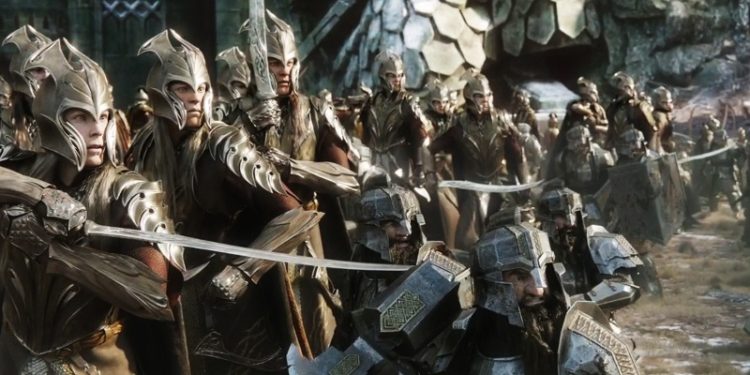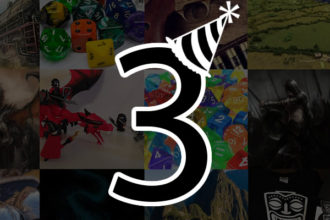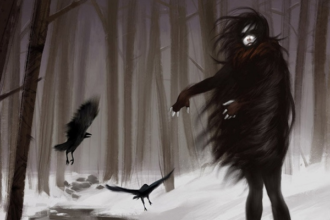Tribal Knowledge: Three-Way Conflict

One of the things I believe most strongly about game-running is that every conflict is more interesting with at least three sides. Their relative strength doesn’t need to be equal, but ideally no side is significantly stronger than the other two put together, because what you want here is constant jostling for the top spot and realigning of alliances. This creates a conflict with almost no chance for a decisive end, at least until you want a decisive end. It also puts more pressure on the PCs to make ugly, difficult choices, which in my book is what you want as a GM. After all, even refusing to compromise and facing a harder struggle means they have recapitulated their heroic ethos, and can now test it.
Let’s take it as a given, for the purposes of this article, that you want all of the PCs on the same side of this conflict. There are tabletop games where PvP conflict is a major feature of play – Apocalypse World and Smallville spring to mind – and if you’re playing those, well, I’ll wind up talking a little bit about that kind of situation too.
In constructing any kind of faction, you want to unify them around something, whether that’s a political body (such as a kingdom) or a philosophy (such as D&D’s presentation of Hell as the absolute philosophical expression of Lawful Evil). I’ll lay out a few examples of how this can work from campaigns I’ve run. One of the foundational texts of D&D is also a great example of this: Moorcock’s version of Law, Chaos, and Balance, and how Elric interacts with them. In that example, at least, I don’t think any two sides ever ally to attack the third (but there’s plenty of Elric I haven’t read). Here are three examples of campaign-scale conflicts with three or more sides, taken from my own collaborative work.
Dust to Dust: The Most Foul and the Houses of the Nether
In the distant past of the Dust to Dust setting, there were two gods, the Master Shaper and the Breath of Life. They contended over whether free will had meaning and value for mortals, with the Master Shaper preferring rigid order and the Breath of Life favoring free will. They decided that the best thing to do was to create a world and populate it to test their ideas. The Master Shaper formed the world from nothingness, formed the bodies of the animals and the sentient mortals. Only the Breath of Life could make them live. A collection of lesser spirits, from Titans on down to the least messenger-spirit, aided the Master Shaper in the construction of the world and all that is in it.
No one knows what conclusion they came to on the first world, or the second that they made once they lost interest in the first, or the hundreds after that. Their debate became more acrimonious, particularly when the mortals refused to worship the Master Shaper in the way that he felt he deserved. The Breath of Life never sought worship, but received it often enough all the same. The Breath of Life and its Heavenly Host came to call him the Most Foul.
In the world that we care about, the one where the game takes place, the Master Shaper decided he was done being indirect, and caused an avatar to be constructed so that he could organize the world properly, which is to say he planned to conquer it. The mortals, with the aid of the angels who surrendered immortality to join the war, fought back and slew the Most Foul. As he died, he laid a curse upon the world with all his wrath. Further, as long as the Most Foul is dead, he cannot move on to create new worlds; this world is the end of Creation.
There was a great struggle among the Titans, which – because of their nature – was resolved in a moment. Five of the Titans saw that the world was corrupted and ruined by the Master Shaper’s curse, and it should therefore be destroyed so that they could cleanse it and make it anew. Two felt that, cursed or not, they still had a duty to the world as it was. One still slept under his mountain, at the forge where he had shaped the bodies of the mortal races.
When our story starts, then, the five Titans who believe the world should be destroyed have become the Houses of the Nether. The Most Foul still has servants in the world, mortals that he exalted with his power. The PCs are thrown into the middle of a war between annihilation and enslavement, with the help of heroes from the ancient past – those who fought and slew the Most Foul before – and a new descent of angels.
Dust to Dust: Amraoth and Khilest
Another three-way conflict within the Dust to Dust campaign, which was just beginning to unfold as the campaign concluded, was between two groups of outsiders from the Realms Above – the planes between Heaven and the world. “Above” does not signify any moral rectitude in this case, just relative cosmic position. Amraoth and Khilest are cities that encompass nearly all of the planes in which they reside.
The Amraothans have total security and no concept of scarcity for their personal needs within the walls of their city. Most of them are strict isolationists who care only for aesthetic perfection. A few of them remain engaged with other Realms and the mortal world: the Patrons (who look to mortals for new artistic ideas, to prevent total stagnation in Amraoth) and the Crusaders (who explore the cosmos and cause all sorts of havoc, some of it well-intentioned).
The Khilesti have enemies and scarcity, because consuming and scheming give meaning to their existence. Modeled closely on the cenobites of the Hellraiser franchise, they revel in horror and unspeakable depravities. Their chief form of art is long-term performance: to choose one creature and manipulate their lives to the point that they suffer in ways no one has ever suffered before. The Khilesti are obviously, unmistakably horrific in every regard, but they’re engaged with the world and willing to cut deals with anyone.
Now, we didn’t actually run the full story of conflict between Amraoth and Khilest, but it was one of my ideas for what a second arc of Dust to Dust could be, or at least what one of the major stories of such a campaign could be. All of the unresolved questions of how you would get PCs involved in this conflict, and keep them involved, are things we would discuss in writing the campaign. This idea was way more interesting to me than to anyone else, though.
Shooting from the hip a bit, then, the Khilesti take steps to draw the Amraothans out – assassinating their Heralds, hiring people to steal from them, and so on. Getting the PCs to oppose Khilest is trivial. Getting them to oppose Amraoth involves either needing their help against a different threat (and thus opposing their indolence), or getting angry about something the Crusaders did – as happened late in the campaign, when a squad of Crusaders showed up and murdered a dragon just to harvest her bones.
Just as the Most Foul and the Houses of the Nether are about domination versus annihilation and the legitimacy of rulership, Amraoth versus Khilest would be about beauty, suffering, and questioning the obligations of power.
Aurikesh: PCs on Multiple Sides of a Conflict
In the Aurikesh campaign setting, the fundamental cosmic conflict is about which group of Powers gets to structure the rules. There are a lot more than three sides to this fight – there’s the Five Gods, Sechir (the sixth and forbidden God), the Fey Highlords, Hell, the Abyss, the Nightwalker, the Abominations, and the Dark. The PCs can side with and draw power from any of these – and drawing power from one of them doesn’t necessarily mean you side with them, or vice versa.
Right now, the Five Gods are in control of the world, and they structured the world around their own concepts of justice, oaths, causality, and object permanence. All of the other Powers want to push them out and take control of Aurikesh. Clerics, monks, most wizards, and most paladins draw power from the Gods. One of the main antagonists at this point is an angel of Sechir who wants to trigger a war that will destabilize various countries enough that he can advance his master’s goals.
The Fey came from a parallel world (my Feywild is called the Hidden World), and believe that they could do a more interesting job than the Gods do. They want the world to function on poetic justice and narrative logic. The PCs have a lot of connections with the Fey at this point, even if they don’t necessarily want to depose the Gods. But then, the Fey are willing to ally with the Gods long enough to stop some of the other powers. It would be at least as bad for them if Sechir or the Nightwalker won as it would be for the Gods, so it’s pretty easy for PCs with loyalty to the fey to get along with those who are loyal to the Gods. The Oath of the Ancients paladin can draw power from the fey or the Gods.
The Gods created Hell to purify the souls of the dead for re-use. It… sort of works. Okay, it’s not great. Hell seeks out various sins and punishes them, during and after the sinner’s life. They have zeal without safeguards, though, so they lure innocents into sin and let one sinner off the hook if that person helps them convict more or better targets. Hell wants to turn the whole world into a cycle of sin and conviction. (Redemption is a distant afterthought.) The Oath of Vengeance paladin can draw power from Hell or the Gods.
The Abyss is the all-consuming tempest over which Aurikesh so delicately floats. It’s a pretty straight lift of the Elemental Chaos, and has only come up in play about twice. I’ll drill down on it a lot more if I ever wind up needing that content.
The Nightwalker is another case of the Gods trying something that didn’t really work out right. The Ghostlands (my version of the Shadowfell) give rise to a titanic being of death and decay called the Nightwalker, who cyclically tries to conquer the Ghostlands so it can incarnate in Aurikesh. Then it tries to turn Aurikesh into another dead world under its control, until mortal heroes defeat it and send it back to the Ghostlands to start over again. Every other Power, except possibly the Abyss, opposes the Nightwalker… but the Nightwalker can prevent spells to raise the dead from working, so mortals have a compelling reason to bargain with it. It’s also immensely useful for teaching necromancers things you wish necromancers wouldn’t learn! (Both of these things have happened in the campaign so far.)
The Abominations are Lovecraftian horrors that came about because mortal wizards teleported to the other planets. This exposed them to all sorts of things they were unprepared to face, drove them mad, turned them into monsters, and sent them back home. The Abominations don’t come up all that often, but when they do, it’s super bad. I’ve had three PCs with connections to the Abominations so far. They’ve more or less been Call of Cthulhu investigators at various points of Sanity degradation.
The Dark has come up even less, and since explaining it would be a campaign spoiler for most of my players, I’ll leave it there. It’s not nice, but it’s not (exactly) malevolent either.
The way I can support having PC opinion split on this is that their first loyalty should be to the mercenary company they all work for (in theory), and the Powers they support have not yet been opposed to the Company’s continuance. There have also been some fairly heated arguments over which of several conflicting plans to follow, but we’ve avoided irreparable schisms so far. Admittedly, the PCs that decided to put the Good Fellow on the mercenary company’s board of directors might have been taking a big risk with that, but they presented it to the rest of the players as fait accompli.
Edit: One of the players involved has pointed out just how unfairly slanted my choice of words is here. In actuality, they freed the Good Fellow from a prison cell to get his help on a very complicated problem, and the Good Fellow used that opening… and a lot of mental influence… to get an interim member of the board of directors to step down and appoint him to the post.
As the campaign progresses, I think there’s an ever-increasing chance that some PCs will come to irreconcilable conflicts. It may become important that most players have multiple characters, and those characters generally have very different viewpoints from one another. I don’t think it will ever just become a PvP bloodbath, but I guess we’ll see.
Conclusion
These are three models of conflicts with three or more sides, taken from games I’ve run. There are tons of other great examples in world history: let’s start with Capitalism and Communism teaming up to beat Fascism in WWII, only to fall to fighting between themselves in the Cold War. It’s an oversimplification, but painting in broad strokes is part of the initial-planning step of game-running. The nuance comes in later, as you build individual situations and encounters.
I hope you’ve enjoyed my contribution to the Tri-versary, and next time you’re designing the core conflict of a long-term campaign, remember that three or more sides makes objects more stable, but conflicts a lot less so. That’s just the kind of dicey situation you want for maximum tension in a game.



